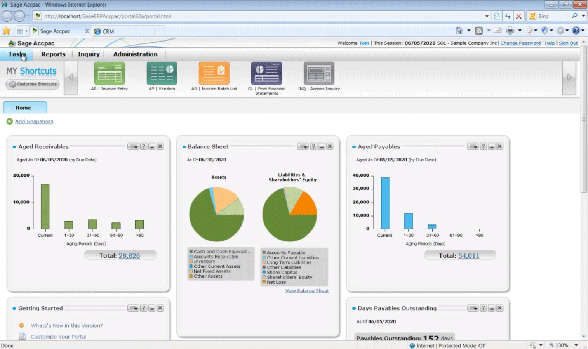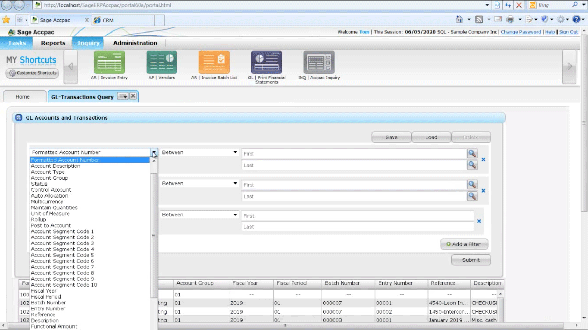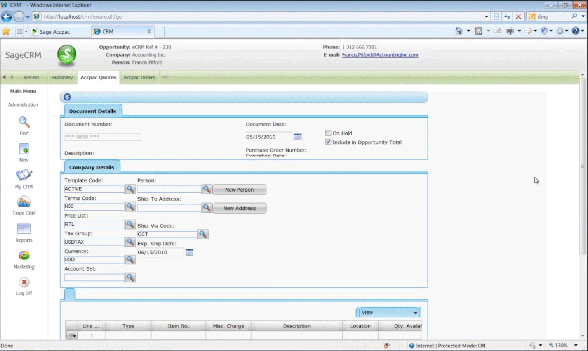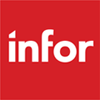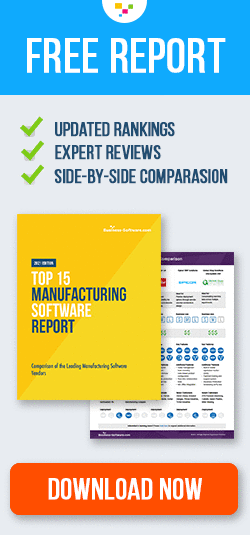Browse Business Software Categories
ERP
MANUFACTURING
Sage 300 ERP Review
Product Snapshot
Product Pricing
Contact vendor directly for pricing information.
Technology
Sage 300 ERP (formerly Sage ERP Accpac) is available as both an on-premise and online solution. This flexible architecture helps a company’s collaboration, mobility, as well as driving performance efficiency through real-time business intelligence and analytics. You can choose the technology and applications that suit your business best, delivering the low TCO and competitive investment protection all businesses want and need.
Customer Focus
Sage 300 ERP was built especially for small and mid-sized businesses that require comprehensive compliance capabilities and strong financial accountability. As a highly adaptable solution, it evolves and changes in response to the altering conditions of your company, supporting growth, which allows users to prosper in a more and more global business environment.
Select Customers
Vineland Estates Winery, Roger Electric Company, Carroll Plumbing at Heating, The Second Cup Ltd., Alberta Construction
Customer Case Studies
About Sage 300 ERP
 Traditional ERP solutions deliver an automation platform that connects business areas such as accounting, manufacturing, warehouse, and distribution. These days, ERP solutions have developed to include marketing, sales, business analytics and customer service, using real-time KPI dashboards and business intelligence. Sage 300 ERP (formerly Sage ERP Accpac) provides both types of platforms, allowing users to securely connect business processes from every functional area of the company in real-time.
Traditional ERP solutions deliver an automation platform that connects business areas such as accounting, manufacturing, warehouse, and distribution. These days, ERP solutions have developed to include marketing, sales, business analytics and customer service, using real-time KPI dashboards and business intelligence. Sage 300 ERP (formerly Sage ERP Accpac) provides both types of platforms, allowing users to securely connect business processes from every functional area of the company in real-time.
Sage 300 ERP lets users add users and increase functionality, easily modified using modular components, without worrying about the disruption and expense of altering your business management system. Sage 300 ERP’s built-in multi-language and currency support also enables businesses to function on a global level.
About the Company
Sage North America is the North American company of UK-based The Sage Group plc, the leading global supplier of business management software and services. For 40 years, Sage North America has delivered easy-to-use, scalable, and customizable software for accounting, customer relationship management, human resources, merchant services, time tracking, and the specialized needs of the construction, distribution, manufacturing, nonprofit, and real estate industries.
Sage North American’s parent company, The Sage Group plc., reaches a global client base numbering more than 6 million SMB customer worldwide. It serves these businesses through more than 12,300 employees in operations in North America, the UK, France, Germany, India, Ireland, the Middle East, Portugal, Spain, Switzerland, South Africa, Australia, and Southeast Asia.
Sage 300 ERP Key Features
- Customizable and scalable General Ledger to handle demanding budgeting and processing needs and grows with your business
- Global multi-currency capabilities handle unlimited currencies and rate types with real-time revaluation
- Robust Accounts Payable and Accounts Receivable features to provide rapid entry and payment of invoices, flexible cash disbursement and fully integrated bank reconciliation
- Global multi-currency capabilities include unlimited currencies and rate types and real-time revaluation
- Powerful inter-company and consolidation capabilities make managing multiple locations and subsidiaries easier
- Fully customizable Checks & Forms Printing to facilitate easier, faster and more secure document printing
- Simplify sales and use tax rate calculations with Sage Sales Tax; a cloud-based, connected service that helps companies ensure compliance with complex sales tax regulations
- Sage 300 ERP Intelligence helps companies eliminate redundant data entry, automate workflows and improve productivity
- Sage 300 ERP Insight maximizes enterprise-wide reporting, budgeting and consolidation applications
- Alerts and Alerts Server enhance communications from the back office, front-office and e-commerce systems
- Customer Relationship Management solution provides out-of-the-box integration with Sage 300 ERP to profile, track and target customers for improved ROI
- Automates business processes to synchronize sales, marketing and customer care activities across the organization
- Confidently manage relationships while focusing on driving revenue through targeted campaigns, informed up-sell and cross-sell opportunities and improved customer nurturing
- Sage Abra leverages HR’s knowledge, processes, and systems to achieve optimal return on employee investment
- Sage Abra includes payroll processing, employee administration, registration, analysis, life-cycle management and manages all other crucial employee information
- Helps companies bring together, analyze and report on multiple business units, subsidiaries, companies and countries within the organization
- Set up multiple companies in one or more databases, run processes, close books and report results by company or in a consolidated company
- Provides integrated systems tp improve collaboration and connectivity between locations
- Leverage business intelligence to consolidate financial information across multiple companies
- Helps companies that conduct business worldwide with built-in support for multiple languages and multi-currency transactions
- Companies can capitalize on the global economy by supporting and guiding subsidiaries nationally and internationally
- Hard and soft consolidation of general ledger transactions and inter-company processing
- Global localization with language translations per system user
- Simplified multi-currency transactions that provides insight into how the international arena is impacting your bottom line
- Support for multiple languages (ships with five out of the box) that can be set per user, currencies, and flexible configurations to support multiple legislation
- Can be implemented at multiple locations
- Complete multi-location Inventory Control system helps to ensure accurate, optimal inventory supply without costly shortages or overages
- Purchase Order module provides a comprehensive, fully integrated purchasing system when combined with Accounts Payable, Inventory Control, and Order Entry
- Comprehensive Order Entry capabilities facilitate orders and encourage up-selling and cross-selling
- Return Material Authorization tracks the entire sales process and gathers intelligence while helping to lower costs on returns or repairs
- Sage FAS Fixed Assets helps companies effectively manage the lifecycle and efficiency of your fixed assets
- Integration with Customer Relationship Management (CRM) improves retention, up-selling, and winbacks
- Allows companies to automatically connect to merchant accounts for credit card authorizations and settlements
- Accurately processes payments through the Order Entry and Accounts Receivable modules
- Provides complete and secure 24/7 online transaction reporting
- Safely stores credit card numbers in the Sage Payment Solutions Vault
- Supports Credit Verification Value (CVV2) to verify card authenticity
- Helps companies maintain compliance with Visa and MasterCard Payment Card Industry (PCI) data security standard
- Optimize multiple address verification, adding an additional layer of credit card authentication
- Streamlines call center to quickly present all information to the staff when they need it
- Improve customer care through workflow and tasks managed by Service Level Agreements
- Expand products, services and locations to meet customer demands around the globe
Sage 300 ERP Screenshots

Pros
- High security features, such as encrypted credit card info in some modules.
- Robust multi-language and currency features.
- Comprehensive tax features.
- Supports different platforms, making the integration process easier.
- Well-reviewed customer support center.
Cons
- The price tag can be pretty hefty, but they do offer discounts for long term projects.
- Ease of use is not very high, so training is required before implementation and deployment.
- Though 300 covers many functions, it’s often an overwhelming amount.
Overall
Sage 300 ERP software easily supports differing company platforms, so it can be tailored to meet your operation specific and industry specific needs. Sage 300 ERP also gives you the flexibility and scalability necessary to grow and expand as your business needs grow and expand. Sage is also well known for having extremely helpful and comprehensive customer support, which makes up for the slight learning curve in adapting to their software.
White Papers and Demos
White Paper provided by Sage
Managing massive volumes of information requires time and resources—two luxuries that most lean-and-mean businesses simply don’t have enough of today. A cost-efficient solution to this challenge is an Enterprise Resource Planning (ERP) system that allows you to integrate all your management processes into a single, coherent information system.
White Paper provided by Sage
When evaluating ERP systems for purchase, one important criterion lies in whether customers are looking for an on-premise ERP solution, a cloud-based ERP system, or a hybrid combination of the two.
White Paper provided by Sage
The search for the right Enterprise Resource Planning (ERP) provider can be stressful, particularly when both the buyer and the vendor get stuck in the features or technical requirements and forget about the bigger picture—what the main business issues are that you actually trying to solve and whether this new investment will actually help you resolve these specific challenges.

